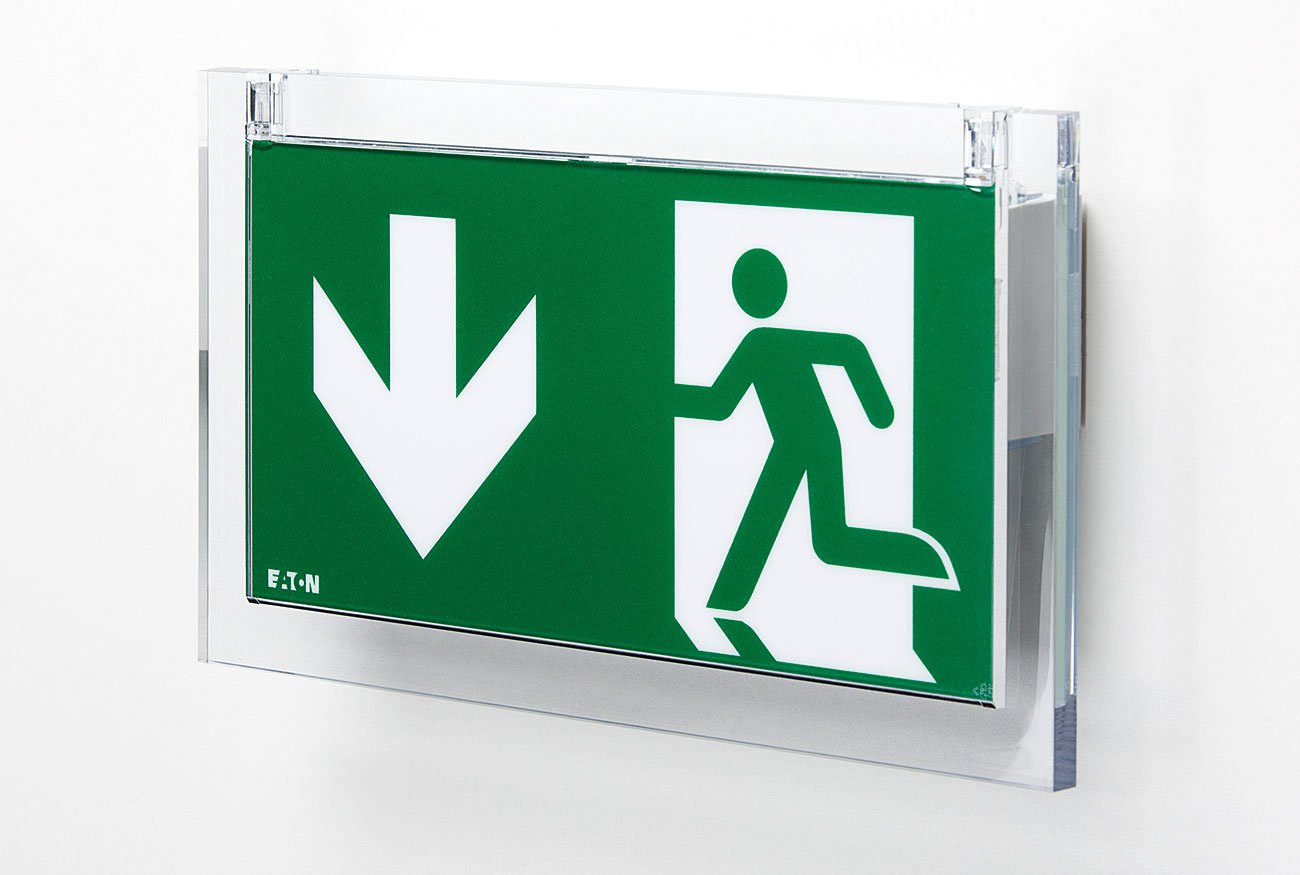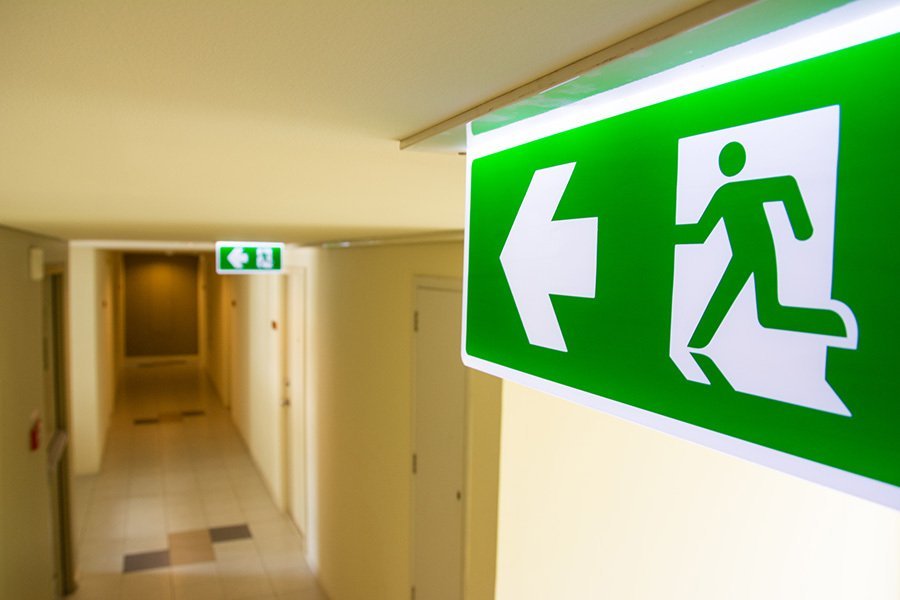
Emergency and Exit Lighting System
Emergency exit light systems are designed to direct occupants of the building to safety by providing visibility in the event of a power failure or any emergency. In the event of an emergency, emergency lighting is the first line of escape. This is part of an active fire prevention system and is installed throughout all buildings as part of the safety provisions of a building.
The emergency lighting system is an integral part of the overall design of a building to reduce anxiety and stress should a power failure take place. In the event of a fire when the electrical power supply may be compromised, the evacuation of occupants is challenging. The provision of emergency lighting provides comfort and visual capabilities for safe and effective evacuation through escape routes.
It helps to identify fire alarm panels, call points, firefighting, safety equipment, exit points and hazards such as stairs, changes of direction, intersections, slopes. If the immediate area outside the final exit has hazards in darkness, risk assessment should determine if further emergency lighting is needed until safety can be reached.

Emergency escape lighting is not designed to allow normal operations to be continued in the building in the event of failure of the normal lighting. Standby lighting is used for areas where normal activities are required to continue substantially unchanged in the event the supply to the normal lighting fails. Emergency lighting systems must be installed by a competent person accredited by a professional body.
Variations
Emergency Escape Lighting Categories
Emergency escape lighting itself is sub-divided into three different categories. These are
- Escape route lighting
- Open area lighting
- High-Risk Task Area Lighting

Escape Route Lighting
Identifies a building’s escape route and ensure its well-lit. Includes emergency lighting such as emergency lighting bulkheads and illuminated fire exit signs.
Open Area Lighting
Ensures that there’s enough light for the people inside a building to reach an area where they can identify an escape route.
High-Risk Task Area Lighting
Provides illumination for the wellbeing and safety of persons involved in potentially dangerous situations or processes and allows for the proper shutdown of machinery and equipment for the safety of the operators and those occupying the premises.
Emergency Lighting – Modes of Operation
Maintained Emergency Lighting
This type of light runs continuously and is connected to the building’s lighting system. During a power outage will operate at a lower light output level. Maintained Emergency & Exit lights are addressable and can be easily found out in case of replacement/damage.
Non-Maintained Emergency Lighting
A Non-Maintained Light is fitted with its own rechargeable battery. This light is connected to the main electrical lines of the building for charging. During an outbreak, these can provide lights up to 3hrs.
Sustained Emergency Lighting
Where an emergency luminaire has two or more lamps, at least one of which is operated from the emergency supply, and the remaining are from the normal mains supply.
Main Categories of Emergency Exit Lighting Systems
Self-Contained Emergency Lighting System
In the self-contained systems, each emergency and exit light has its own backup power source, traditionally a battery. This kind of a system is the most applicable in such buildings, where the maintenance of the batteries, located in each luminaire, can be arranged with reasonable costs.
Central monitoring Emergency Lighting system
A central monitoring system monitors emergency and exit lights systems and other components of emergency and exit light systems. Monitoring systems make maintenance and fault rectification easy.
Central Battery System
Central Battery System for Emergency Lighting means, that the backup power source for the Emergency and Exit Lights is provided centrally. In other words, each Emergency and Exit Light does not need to have a battery or super capacitor of their own.
Standby Emergency Lights
There are two types of emergency lighting: safety lighting and standby lighting.
Standby lighting : When there is a power loss at the location – whether commercial, residential, or open-air – the standby emergency lights come in handy. Work can continue with standby lights. In industrial settings, for example, mains-independent emergency lighting enables critical work to be completed or equipment to be shut down safely.
Safety lighting : It is utilized to allow employees or visitors to securely exit a building.
Emergency exit Light System Suppliers in Dubai
Emergency lights are an essential component of a building’s lighting system: without them, everyone is left in the dark in a power failure situation. Reliable emergency lighting is thus essential for the safety of building occupants. This is also applicable to areas that require very strong illumination.
Wermany is one of Dubai’s leading fire Fighting and ELV solutions providers of top-rated and high-quality products. We are one of the leading suppliers of emergency exit lights in Dubai. We are the leading distributor and wholesaler of emergency exit lights and all types of fire fighting and ELV systems.
FEATURES AND BENEFITS
- You will always have lighting under any circumstance
- It creates a visual pathway for employees, guests and you
- It can be a blessing if you often suffer from power cuts
- Better recognition of escape routes
- Avoids panic by getting the occupants to a place where an escape route can be accessed
- Allows normal work to continue in a building until the main power supply is turned back on
APPLICATIONS
- Work Places
- Educational Facilities
- Hotels
- Healthcare
- Industry
- Public Buildings
- UPS Systems, etc.
FAQ – Emergency and Exit Lighting System Dubai
An emergency exit system is a planned and designated route or mechanism for quickly and safely evacuating a building, vehicle, or enclosed space during emergencies such as fires, natural disasters, or other dangerous situations.
Emergency exit systems are crucial because they provide a means for people to escape from potentially life-threatening situations. They are a fundamental component of safety in buildings, vehicles, and public spaces.
Common types of emergency exit systems include:
Exit doors with panic bars or push bars.
Emergency lighting to illuminate exit paths.
Fire escape stairs or ladders.
Evacuation slides in aircraft and some vehicles.
Emergency exits in vehicles like buses and trains.
During an emergency evacuation, stay calm, follow the marked exit routes, and do not use elevators. Help others if you can, but prioritize your safety. If there is a fire, stay close to the ground to avoid smoke inhalation.
No, emergency exits are designed for various types of emergencies, including fires, earthquakes, power outages, gas leaks, and more. They provide a quick way to exit a building or vehicle in any situation that poses a risk to occupants.
At Wermany, your safety is our top priority. We’re here to assist you with all your fire system needs. If you have any questions, need support, or want to discuss your fire protection requirements, please reach out to us.
